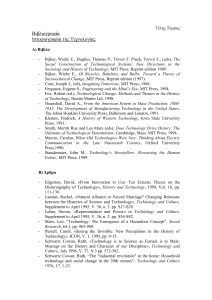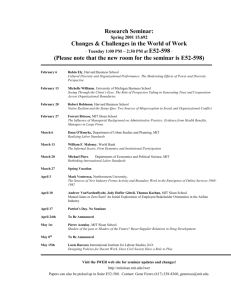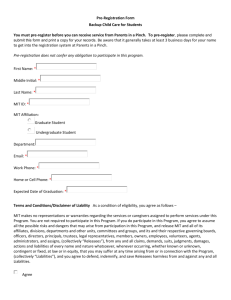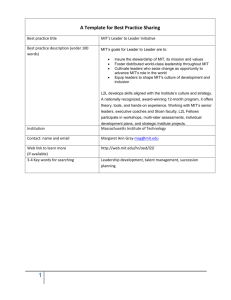Zero Waste MIT Events Planning Guide
advertisement
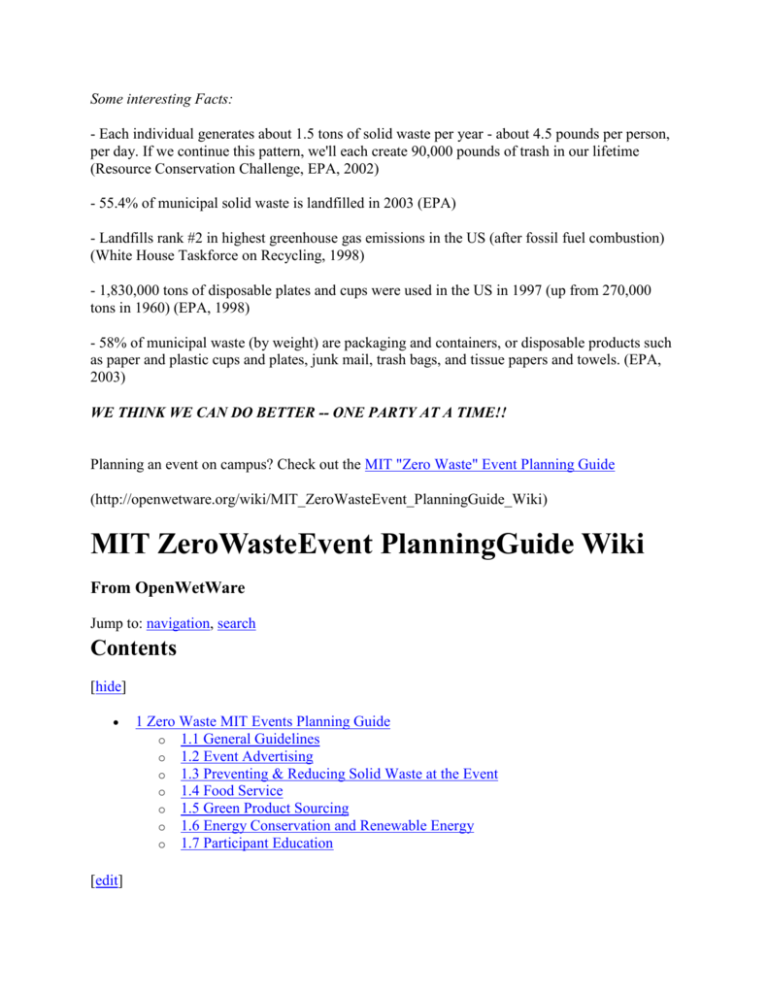
Some interesting Facts: - Each individual generates about 1.5 tons of solid waste per year - about 4.5 pounds per person, per day. If we continue this pattern, we'll each create 90,000 pounds of trash in our lifetime (Resource Conservation Challenge, EPA, 2002) - 55.4% of municipal solid waste is landfilled in 2003 (EPA) - Landfills rank #2 in highest greenhouse gas emissions in the US (after fossil fuel combustion) (White House Taskforce on Recycling, 1998) - 1,830,000 tons of disposable plates and cups were used in the US in 1997 (up from 270,000 tons in 1960) (EPA, 1998) - 58% of municipal waste (by weight) are packaging and containers, or disposable products such as paper and plastic cups and plates, junk mail, trash bags, and tissue papers and towels. (EPA, 2003) WE THINK WE CAN DO BETTER -- ONE PARTY AT A TIME!! Planning an event on campus? Check out the MIT "Zero Waste" Event Planning Guide (http://openwetware.org/wiki/MIT_ZeroWasteEvent_PlanningGuide_Wiki) MIT ZeroWasteEvent PlanningGuide Wiki From OpenWetWare Jump to: navigation, search Contents [hide] [edit] 1 Zero Waste MIT Events Planning Guide o 1.1 General Guidelines o 1.2 Event Advertising o 1.3 Preventing & Reducing Solid Waste at the Event o 1.4 Food Service o 1.5 Green Product Sourcing o 1.6 Energy Conservation and Renewable Energy o 1.7 Participant Education Zero Waste MIT Events Planning Guide This guide will help members of the MIT community to plan and execute meetings, parties, or other events with a goal of minimizing waste and environmental impact without sacrificing the quality of the event. The guide outlines the most important factors to consider and provides information about local resources available to reduce your event’s environmental footprint. The guide was created through experiential learning in planning MIT’s first annual “Zero Waste Party” in conjunction with Earth Day in April of 2006, sponsored through a MIT Graduate Student Life Grant. See Zero Waste Party 2006. This document also draws heavily from other green event planning guides. General Guidelines Be aware and creative in minimizing waste and environmental impact. Assign leadership roles amongst the event planning committee for working toward a zero waste event. Event Advertising Take advantage of electronic media for publicizing the event. Create an event web site. Offer electronic registration or confirmation. Uses flyers sparsely and strategically and assure that they are recycled when removed from bulletin boards. LSC slides during the movie are available for each event at a cost of $40 per weekend. Information is available at http://lsc.mit.edu/info/slides. All ASA-recognized student groups receive a total of 80 column-inches (equivalent to one full page) of free ad space in The Tech per academic year, split however they wish. Deadlines for advertisements are on a Tuesday-Friday system; all copy must be received by 4:30 p.m. on Friday for Tuesday publication, and by 4:30 p.m. on Tuesday for Friday publication. Projectors in the Infinite Corridor are available for $80 per projector and $125 for both. There can be a discount for ASA recognized student groups but need to be booked well in advance (4 months). Information is available at http://web.mit.edu/av/www/morehtml/corridor_3.htm Preventing & Reducing Solid Waste at the Event Avoid mass distribution of paper hand-outs. Distribute copies of handouts or slides electronically via the web after the event. Use double-sided printing for any materials to be distributed. Limit the use of glossy paper to applications where it significantly improves the publication. Assure that a sufficient number of well-labeled recycling receptacles are available throughout the venue (along with garbage containers to make sure recycling bins aren’t contaminated). Provide and later re-collect reusable name badges Design reusable or recyclable signs for use at the event or use overhead projections. Food Service Plan food service needs carefully to avoid unnecessary waste by accurately forecasting the head-count. Use RSVPs or registration to assist in event planning. Consider the use of reusable or compostable cutlery, dishware and linens. “SfGS Sustainable Containers” can be purchased from Students for Global Sustainability. Provide incentives for attendees to bring reusable items (e.g. mugs, utensils) rather than expect disposable serviceware. Seek caterers that can maximize the use of local, seasonal and organic food. Assure that there are vegetarian meal options. Potential sources around Cambridge for such food service include: Harvest, Veggie Planet, Basil Leaf, Whole Foods, Trader Joes, xxxx, xxxx and surely more. Offer fair trade, shade grown, organic coffee. Serve food buffet style rather than in “box lunch” form. Procure beverages and condiments in resource efficient bulk-packaging (2-Liter, Kegs, etc) rather than individual serving packets. Use cloth, compostable, or post-consumer-recycled-content napkins. Provide food composting services. To do so at MIT, obtain compost bins by contacting XXXXXX. Donate excess food to local shelters, food banks, or soup kitchens. Put it in writing. Include the policies above in the RFP and/or contract for food service. Green Product Sourcing Consider the environmental impact of any raffled prizes, give-a-ways, centerpieces, or decorations to be used at the event, and minimizing the packaging for such items. Innovative resource- or energy-efficient products might be demonstrated (e.g. LED holiday string-lights). Distribute items to attendees that will help them to reduce waste and restore environmental quality in the future (e.g. cloth bags, native plant seeds, potted plants, etc). Select products made from recycled or rapidly renewable materials. List the amount of recycled content and/or vegetable- or soy-based inks used. Energy Conservation and Renewable Energy Select venues that are as energy efficient as possible. Easy ways to assess this include seeking spaces with significant daylighting, modest and energy efficient electric lighting, automated building controls, and well insulated/large thermal mass building envelopes. MIT is currently pursuing LEED certification (Leadership in Energy and Environmental Design) for four new campus construction projects: Stata Center, Simmons Hall, Brain Cognitive Sciences, Sidney-Pacific. Purchase Renewable Energy Credits (RECs) or “green-tags” to offset the emissions of any electricity used for the event. There are numerous competitive certified-REC providers. For a list of providers, see http://www.green-e.org/your_e_choices/trcs.html. The current average price of a REC is 2.5¢ per kWh. To determine the projected energy usage for a particular building on campus, contact MIT’s Director of Facilities Peter Cooper at PLCooper@PLANT.MIT.EDU Select venues adjacent to public transportation and with sufficient bicycle racks. Participant Education Explain the zero-waste objectives of the event to participants, in advance if possible. Provide frequent visual and verbal reminders to recycle and reduce waste. Encourage the return of items that can be reused at another event. Promote the events environmental objectives. See the Washington State University ZeroWaste Picnic for other ideas http://www.wsu.edu/recycle/zerowaste.html Retrieved from "http://openwetware.org/wiki/MIT_ZeroWasteEvent_PlanningGuide_Wiki"




